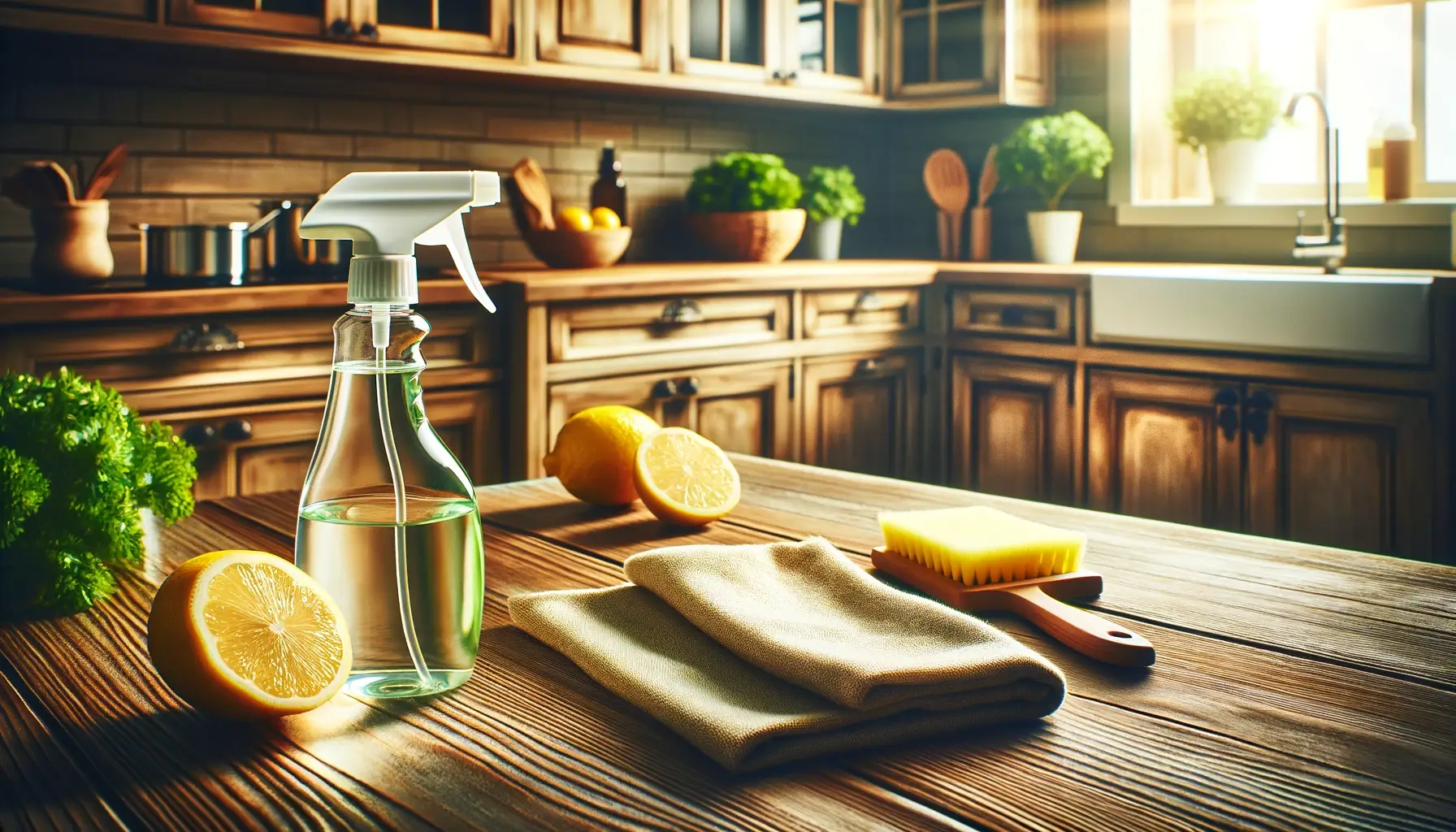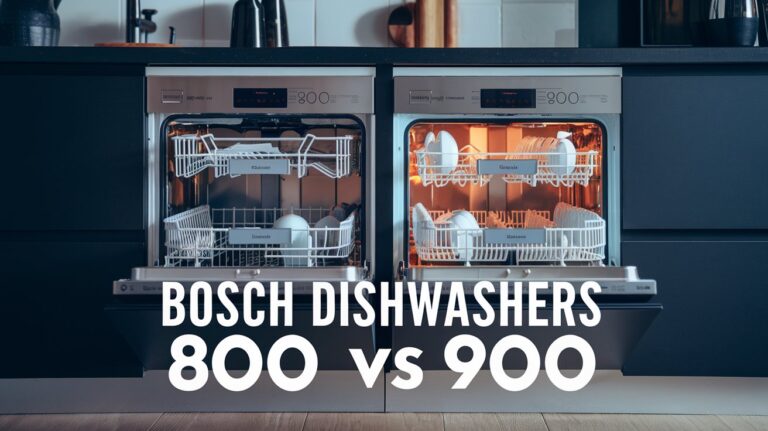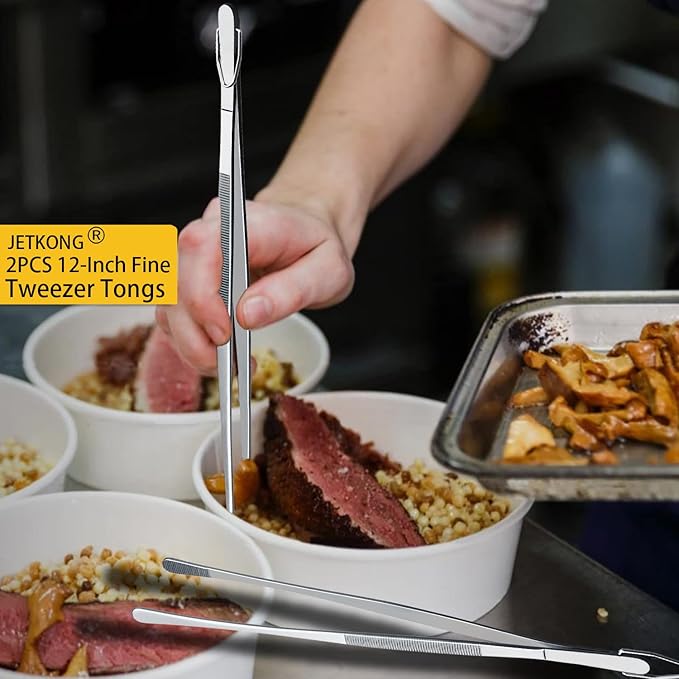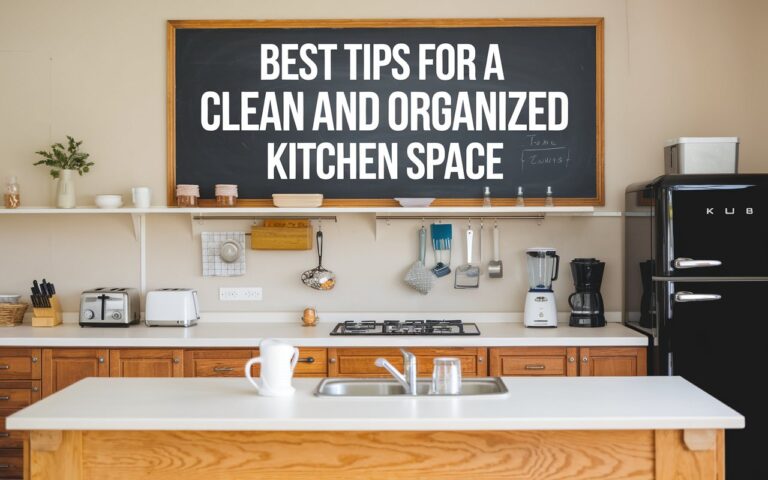Have you ever opened your kitchen cabinet doors only to find them sticking together, leaving a residue on your hands that seems impossible to remove? Sticky wood kitchen cabinets can be a frustrating and unsightly problem many homeowners face, but fear not – there are effective solutions at hand.
Whether the stickiness is caused by accumulated grease, spilled food or simply the passage of time, learning how to properly clean and maintain your wooden cabinets can restore their beauty and functionality.
In this article, we will explore some easy-to-follow methods and tips to help you say goodbye to sticky surfaces and hello to smooth, gleaming wood in your kitchen. So roll up your sleeves and get ready to transform those pesky sticky cabinets into pristine showcases of cleanliness!
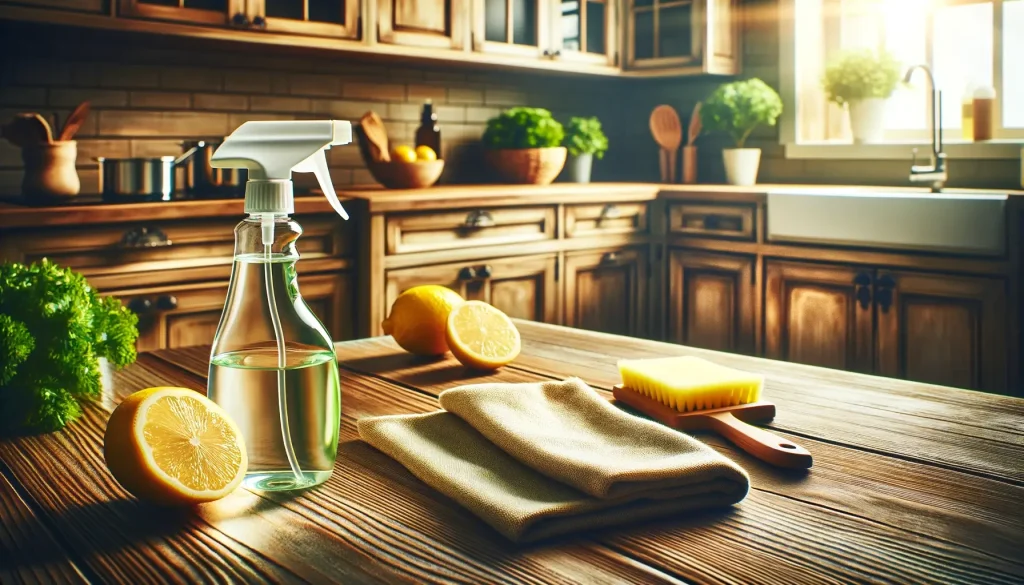
How to Clean Sticky Wood Kitchen Cabinets
Cleaning your cabinets can be done easily using everyday items like vinegar, baking soda, or dish soap. Simply mix these ingredients to create an effective DIY cleaner that cuts through grease and grime.
Save money by avoiding expensive store-bought products and opt for natural solutions that are gentle on your cabinet surfaces. Experiment with different homemade cleaners to find the one that works best for your needs. Remember, you don’t need a long list of supplies to maintain clean and shiny cabinets at home.
When it comes to household cleaning, the methods you select greatly influence the supplies you require. For a thorough cleaning session, consider having these 10 unique items on hand:
- Baking soda for its gentle abrasion and deodorizing properties.
- Blue Dawn dish soap, a highly versatile cleaner that tackles grease effectively.
- White vinegar, a natural disinfectant and odor eliminator.
- An orange, which can be used to create a DIY citrus cleaner.
- A soft or old toothbrush for detailed scrubbing in tight spaces.
- A durable sponge for general surface cleaning.
- Toothpaste works wonders on removing stains from various surfaces.
- Castile soap is an all-natural soap that can be used in a variety of cleaning solutions.
- Linseed oil for polishing and protecting wood surfaces.
- A large bowl for mixing cleaning solutions or soaking items.
- A spray bottle to conveniently dispense homemade cleaners.
Having these supplies readily available ensures that you are well-equipped to tackle any cleaning task efficiently and effectively.
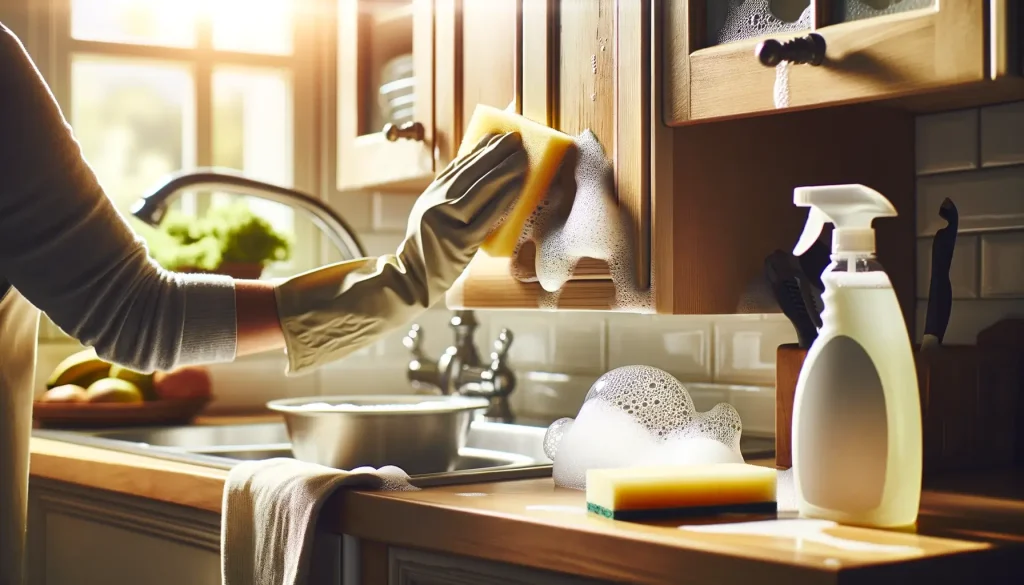
How to Clean Sticky Grease Off Kitchen Cabinets With Dish Soap
To clean sticky grease off kitchen cabinets with dish soap, mix warm water with a few drops of dish soap. Use a sponge or cloth to gently scrub the affected areas. Rinse with clean water and dry thoroughly. For stubborn spots, add a little baking soda to create a gentle abrasive paste.
Here is method number one:
- Fill a bowl with warm water and add a few squirts of blue Dawn dish soap.
- Mix it around to create a bubbly solution.
- Soak a sponge in the mixture, wring out excess water, and use it to wipe down sticky areas on your cabinets.
- Let the solution sit for about a minute to cut through tough grease, then scrub areas with build-up.
- For stubborn, greasy spots, use a toothbrush for extra pressure and friction.
- Dip the sponge in soapy water, sprinkle it with baking soda, and gently scrub the cabinets.
- Be cautious not to apply too much pressure on painted surfaces.
- If white paste forms, add more soapy water as needed.
- Dampen a cloth with vinegar and tap water to remove any soap residue from the cabinets.
Cleaning Kitchen Cabinets With Baking Soda
To clean kitchen cabinets with baking soda, mix it with water to create a paste. Apply the paste to the cabinets using a sponge or cloth, scrubbing gently in circular motions. Wipe down the cabinets with a damp cloth to remove the baking soda residue. This natural and effective method will help remove grease and grime, leaving your cabinets clean and fresh.
For the baking soda method, follow these instructions:
- Create a paste of baking soda and water.
- Ensure the paste is thick, not runny.
- Dip your toothbrush in the paste.
- Gently scrub the sticky area.
- Let the paste sit for a few minutes.
- Give it another gentle scrub.
- Wipe the area with a damp cloth.
- Apply linseed oil to a cloth and re-moisturize the scrubbed areas.
- You can also rub it over the entire cabinet area.
You can use an orange as a natural scrubber by cutting it in half, dipping the cut side in baking soda, and then rinsing it well before applying oil.
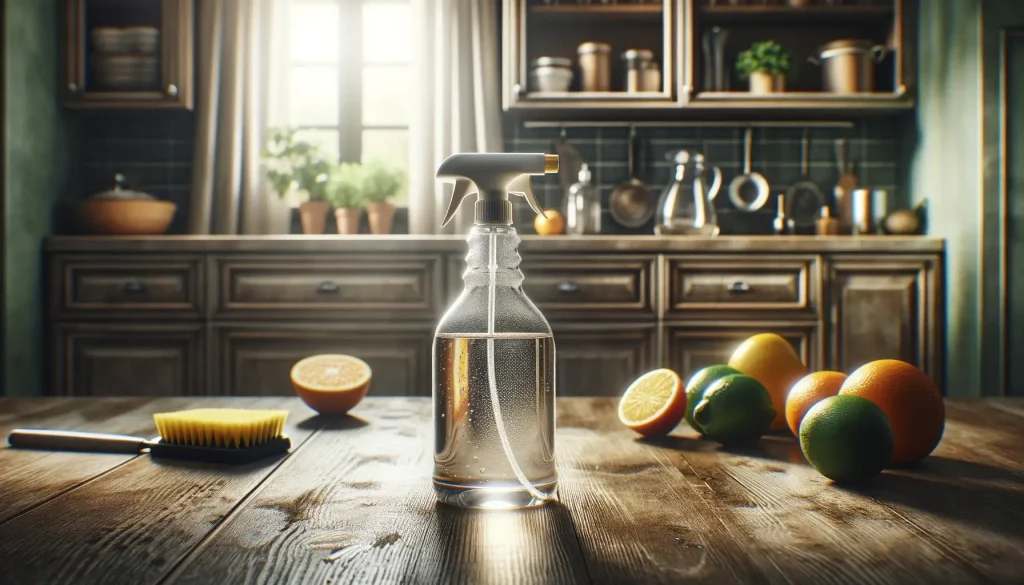
Remove Grease on Kitchen Cabinets With Homemade Vinegar Spray
The effectiveness of vinegar for cleaning cannot be denied, but its acidic nature means it’s not ideal for direct use on wooden cabinets as it may damage the finish. Diluted vinegar, on the other hand, may not be strong enough to tackle stubborn messes. To address this, consider combining vinegar with Dawn dish soap for a more powerful cleaning solution.
- In a spray bottle, mix the following ingredients, 1. 2 cups of water, 1 cup of vinegar, 3. 2 tablespoons of Dawn
- Shake the bottle to ensure thorough mixing.
- Spray the mixture onto the sticky cabinet surface.
- Wipe away grime using a sponge.
- Gently scrub stubborn areas with a toothbrush.
- Use a clean, damp cloth to wipe off any residue.
- For added shine, apply a small amount of linseed oil.
You can use different dish soaps as substitutes, but they may not work as well together. Castile soap is a great alternative to Dawn if you have it on hand, and remember that a little goes a long way with castile soap. For this recipe, you only need 1 tablespoon of castile soap.
How to Clean Grease Off Kitchen Cabinets With Toothpaste
To clean grease off kitchen cabinets with toothpaste, apply a small amount of non-gel toothpaste to a damp sponge. Gently scrub the greasy areas in a circular motion, then wipe clean with a damp cloth.
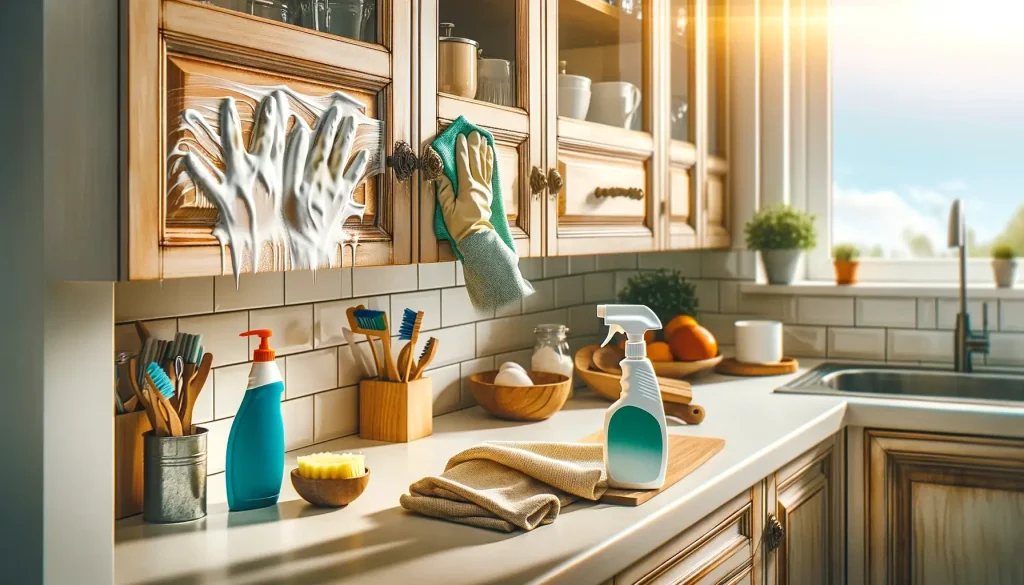
To clean grease off kitchen cabinets with toothpaste, follow these steps:
- Squeeze a small amount of non-gel toothpaste onto a clean cloth or sponge.
- Gently rub the toothpaste onto the greasy areas of the cabinet surface.
- Allow the toothpaste to sit on the grease for a few minutes to help break it down.
- Use a damp cloth to wipe away the toothpaste and grease residue.
- Repeat the process if necessary until the grease is completely removed.
- Finally, wipe down the cabinets with a clean damp cloth to remove any remaining residue and toothpaste.
Note: Test a small, inconspicuous area first to ensure that the toothpaste does not damage or discolor your cabinets.
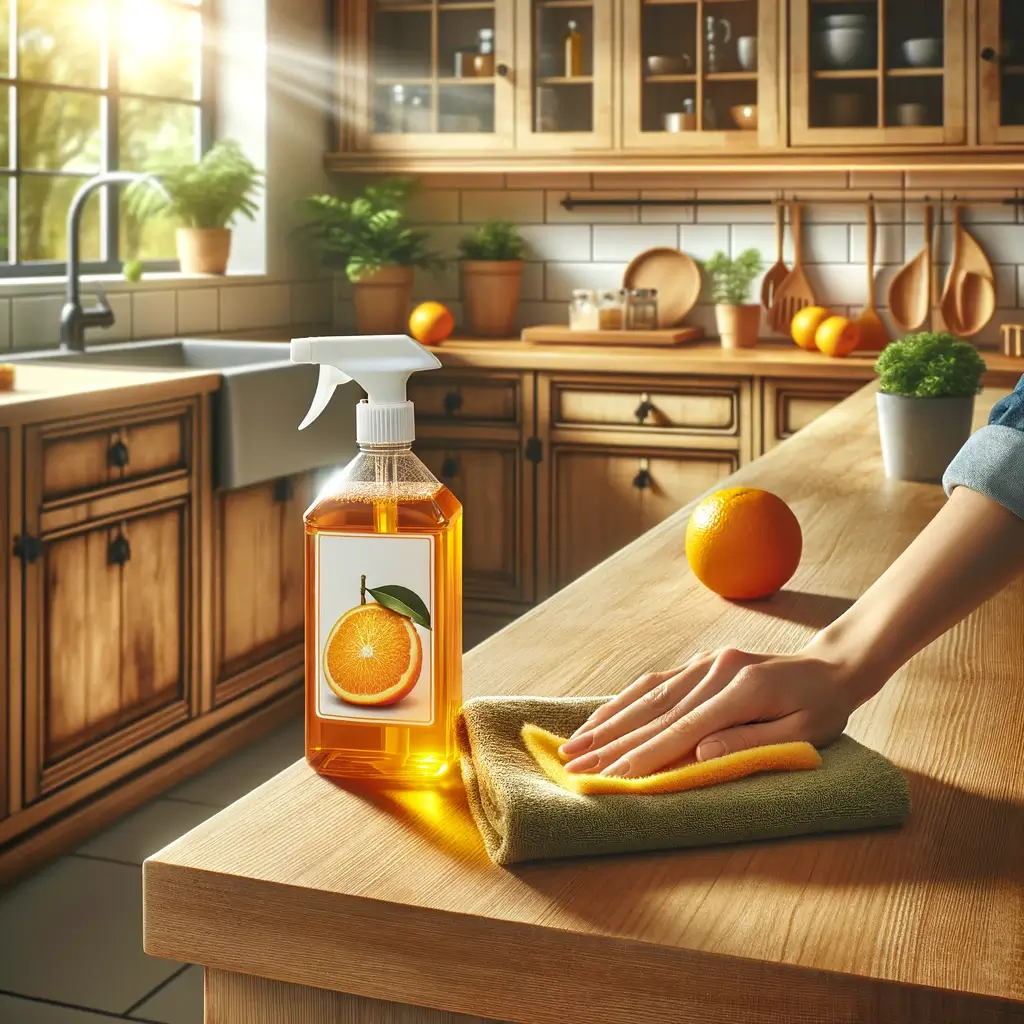
Cleaning Kitchen Cabinets Using Orange Oil
Cleaning kitchen cabinets using orange oil is a natural and effective way to remove dirt and grease buildup. Simply apply the oil with a cloth and wipe clean for a fresh scent.
Follow These Steps:
- Remove all items from the cabinets.
- Mix 1/4 cup of orange oil with 1 cup of white vinegar in a spray bottle.
- Spray the solution onto a microfiber cloth.
- Wipe down the interior and exterior of the cabinets using circular motions.
- For tough spots, let the solution sit for a few minutes before wiping it clean.
- Once done, allow the cabinets to dry before placing items back inside.
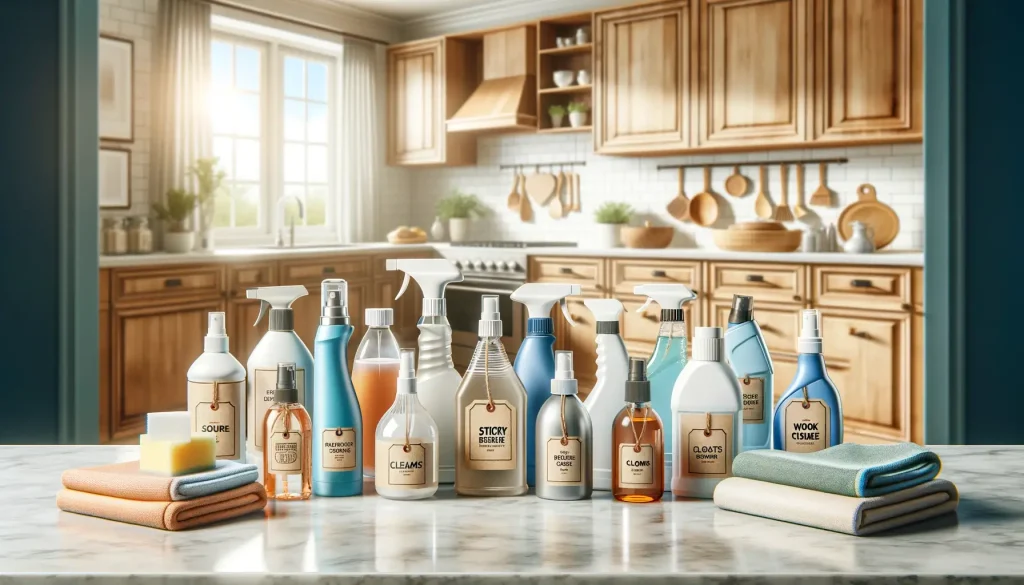
Recommended Products to Remove Sticky Residue From Wood Cabinets
Here are some recommended products to remove sticky residue from wood cabinets:
- Goo Gone Original Liquid – A popular adhesive remover that is gentle on wood surfaces.
- WD-40 – Known for its ability to loosen sticky residue, it can be effective on wood cabinets.
- Mineral spirits – A solvent commonly used to clean and degrease wood surfaces.
- Baking soda paste – Mix baking soda with water to create a paste, which can help break down sticky residue.
- Vegetable oil or olive oil – These oils can be used to soften and dissolve sticky substances on wood cabinets.
Remember to always test any product in a small, inconspicuous area before applying it to the entire surface of your wood cabinets
The Importance of Cleaning Your Kitchen Cabinets
Cleaning your kitchen cabinets is essential for maintaining a healthy and organized cooking space. Not only does regular cleaning keep your cabinets looking new and fresh, but it also helps prevent the buildup of dirt, grease, and bacteria.
Over time, neglecting to clean your kitchen cabinets can lead to unpleasant odors, pest infestations, and even mold growth. By incorporating cabinet cleaning into your regular household routine, you can prolong the life of your cabinets and create a more hygienic environment for food preparation.
Regularly wiping down cabinet surfaces with a mild cleaning solution and removing any spills or stains promptly can make a significant difference in the overall cleanliness of your kitchen.
Remember to pay attention to both the interior and exterior of your cabinets, as well as handles and knobs that are frequently touched. Taking the time to clean your kitchen cabinets not only enhances the aesthetics of your culinary space but also promotes a healthier living environment for you and your family.
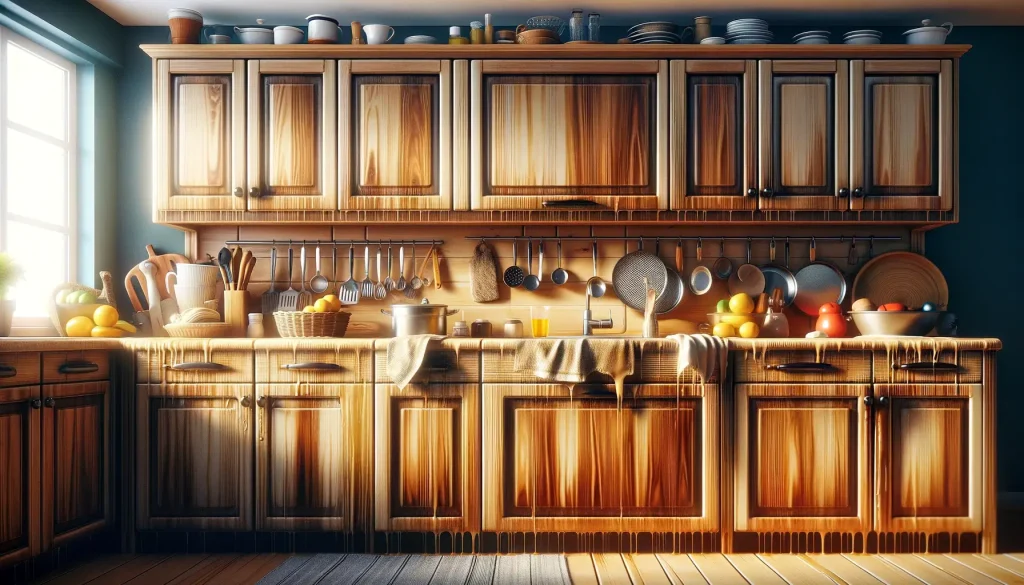
Why Do Wooden Kitchen Cabinets Feel So Greasy
Wooden kitchen cabinets may feel greasy due to a buildup of cooking oils, grease, dust, and other particles that accumulate over time. These substances can be deposited on the cabinet surfaces through everyday cooking activities, such as frying or sautéing.
Additionally, wood is a porous material that can absorb oils and grease, making it more prone to feeling sticky or greasy. Lack of proper cleaning and maintenance can also contribute to the problem.
Regularly cleaning the cabinets with appropriate cleaners and degreasers can help remove the buildup and restore the natural look and feel of the wood surfaces.
Why Clean Wooden Kitchen Cabinets?
Wooden kitchen cabinets should be cleaned regularly to maintain their appearance and durability. Cleaning helps remove built-up grease, food splatters, and dust that can accumulate over time.
Regular cleaning also prevents bacteria and mold growth, creating a healthier environment in the kitchen. Additionally, cleaning wooden cabinets can help preserve the wood’s finish and prevent it from drying out or becoming damaged.
This not only prolongs the life of the cabinets but also keeps them looking fresh and new. Overall, proper maintenance through regular cleaning ensures that your wooden kitchen cabinets remain functional, hygienic, and aesthetically pleasing for years to come.
How To Put Handles On Cabinets
When it comes to putting handles on cabinets, there are a few key steps to follow. Start by measuring and marking where you want the handles to go, ensuring they are straight and evenly spaced.
Then, drill holes in the marked spots using a template or guide to keep them uniform. Once the holes are drilled, attach the handles using screws provided, making sure they are securely fastened.
Finally, double-check that all handles are level and aligned before tightening them completely. Taking your time and being precise in this process will result in a professional-looking finish that enhances the appearance of your cabinets.
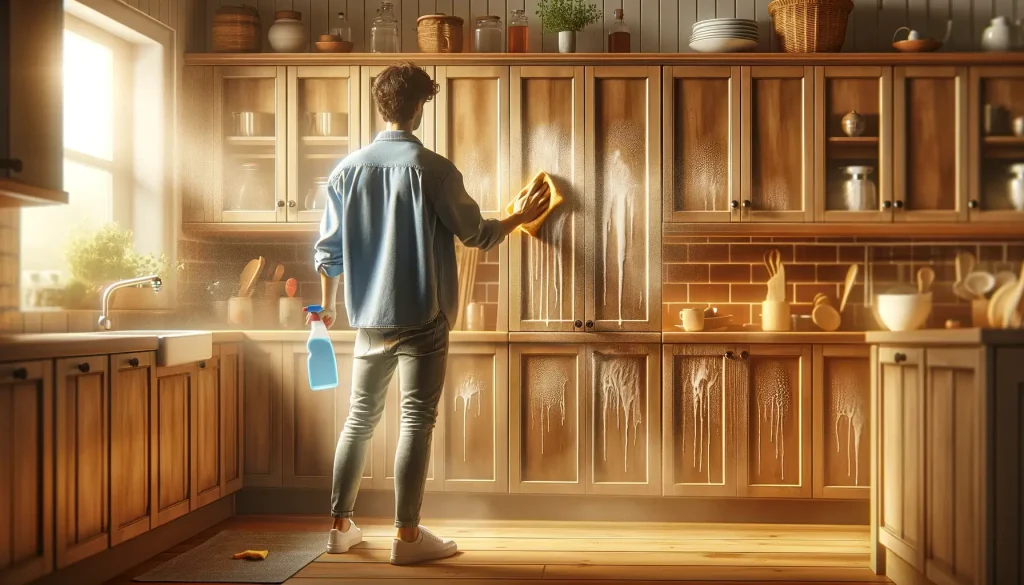
Tips To Care For Wooden Kitchen Cabinets
To keep wooden kitchen cabinets in top condition, it is essential to regularly clean them with a mild soap and water solution. Avoid using harsh chemicals or abrasive cleaners, as they can damage the wood’s finish over time. Additionally, applying a coat of furniture polish or wax every few months can help protect the wood and keep it looking like new.
Another important tip for caring for wooden kitchen cabinets is to prevent water damage by wiping up spills immediately and avoiding excessive moisture buildup. Use coasters under glasses and placemats under hot dishes to protect the cabinet surfaces from heat and moisture damage.
Lastly, consider refinishing or restaining your cabinets every few years to maintain their appearance and prolong their lifespan. Remember, taking care of your wooden kitchen cabinets now will pay off in the long run with a beautiful and functional kitchen space.
Conclusion
Cleaning sticky wood kitchen cabinets can be a simple and effective process with the right tools and techniques. By using a gentle cleaner, warm water, and microfiber cloth, you can safely remove sticky residue without damaging the wood surface.
Regular maintenance and preventative measures such as wiping spills immediately can help prevent future stickiness. Taking the time to properly clean your cabinets will not only keep them looking beautiful but also extend their lifespan. So roll up your sleeves, grab your supplies, and give your kitchen cabinets the TLC they deserve!
FAQs About Clean Sticky Wood Kitchen Cabinets
How do I clean sticky wood kitchen cabinets without damaging them?
Use a mild detergent mixed with warm water and a soft cloth to gently clean the cabinets.
Can I use vinegar to clean sticky wood kitchen cabinets?
Yes, a solution of equal parts vinegar and water can help remove sticky residue without harming the wood.
What is the best way to tackle tough, stubborn stickiness on wood cabinets?
Try using a mixture of baking soda and water to create a paste, then gently scrub the affected areas.
Will using oil-based cleaners make my wood cabinets even stickier?
Avoid using oil-based cleaners as they can leave behind residue that may attract more dirt and grime.
How often should I clean my wood kitchen cabinets to prevent stickiness?
It is recommended to clean your cabinets at least once a month or as needed to prevent buildup of sticky residue.
More blogs like Kitchen Cabinets:
How to Remove Kitchen Cabinets?
How Long Does It Take to Install Kitchen Cabinets?
How Long Does It Take to Paint Kitchen Cabinets?
What Color Should I Paint My Kitchen Cabinets?
How to Make Oak Kitchen Cabinets Look Modern?
How to Separate Your Kitchen and Living Room?
How to Remove Paint from Kitchen Cabinets?
What is a Good Paint for Kitchen Cabinets?

